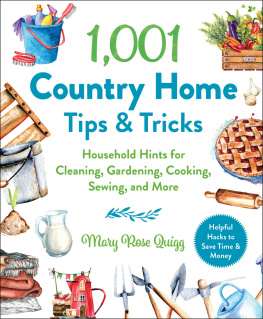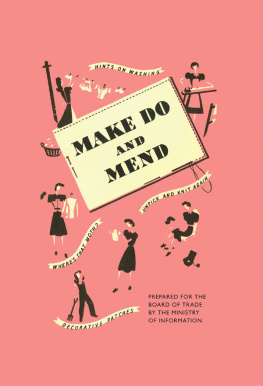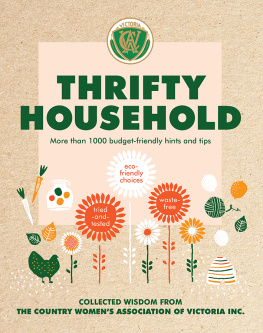Make Do and Mend is the perfect accompaniment to these cash-strapped times. Within these pages you will discover that its not just about making do, its about getting creative: whether you take a pair of scissors to a favourite old dress that has seen better days and revamp it into a bespoke new outfit, with a tuck here and a new fastening there, or you harvest forgotten produce from the larder to rustle up something delicious and homemade rather than dashing to the shops for a ready-meal.
Being thrifty is about saying no to waste, saving money and enjoying the good things in life on a budget, and this guide with tips on how to live inexpensively will show you how. Interspersed with slogans from ration-era Britain to cheer you on, and sage quotes from the worldly wise, youll be cutting up those credit cards in no time!
CLOTHING AND FOOTWEAR
Remove winter salt stains from shoes
by wiping with a cloth dampened in a
vinegar solution. Use one part vinegar to
six parts water.
Restore old shoes by rubbing a sliced
raw potato onto the leather. Polish them
with a cloth and watch them gleam.
Another way to restore the shine on
leather shoes is to apply a dash of
vegetable oil. Use a damp cloth to
remove any dirt, then run a soft cloth
with a drop of oil over the surface to
(literally) add polish.
Dont throw away a garment because
the zip seems stuck fast; rub the metal
teeth with a pencil lead you should
now be able to ease it open.
Add a teaspoon of pepper to a colour wash
to keep colours bright and prevent runs.
Learn how to darn beloved woollen
items when they hole. A fabric shop or
haberdashery department will have a
range of wools or silks from which to
match colours to your garment, as well
as needles for sale.
To deter moths naturally, forget
chemical-based mothballs; simply make
lavender bags to hang amongst clothing
lavender is a natural moth repellent.
To remove dried bloodstains from
clothing, dampen the offending area
with cold water, rub with a bar of natural
soap, create a lather and then work the
lather into the fabric. Rinse with cold
water. Sometimes the process will have
to be repeated, but this is a fail-safe
method to restore fabrics to their
former glory.
Faded colours? Try rinsing your clothes
in water with some vinegar. This helps
get rid of the dulling effect of washing
powder residue that can build up within
the fabric.
Turn garments inside out before
washing (especially corduroy). This
prevents fading (with items such as
denim, black jeans or T-shirts with logos)
and also helps keep your clothes fluff
free on the outside.
If you have chewing gum on an item
of clothing, place the garment into a
plastic bag and in the freezer overnight.
You can then scrape off as much gum
as possible, rub in a little white wine
vinegar and wash as normal.
Look at old knitted jumpers as raw
materials for something else. Consider
unravelling them and reusing the yarn
by knitting or crocheting them into
something new.
Most clothing can be reinforced in
weak places like elbows, the crutch
of trousers, and any other part which
bears a lot of strain or gets rubbed. Any
lightweight material can be used, thus
ensuring garments last longer.
If the front of a blouse has become too
tight, place a contrasting piece of fabric
along the button band. Or if it has long
sleeves, make them short and use the
material left over for your button band.
Dont take the squander bug
when you go shopping
World War Two slogan
The safe way to double your
money is to fold it over once
and put it in your pocket.
Frank McKinney Hubbard
For a blouse which is hardly ever worn
because it is too short in the waist,
working its way out of the top of the skirt,
a deep band of near-matching fabric can
be added all round to the hem which
once tucked in will be barely noticeable.
Place a few needles, pins and thread
into a matchbox for an instant
sewing kit.


















